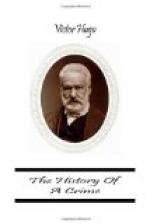The severest rebuke was administered by Antony Thouret.
He looked Sieur
Duponceau in the face, and said to him, “You
deserve to be named Dupin.”
The Usher in truth was worthy of being the President, and the President was worthy of being the Usher.
The flock having been counted, the classification having been made, there were found to be thirteen goats: ten Representatives of the Left; Eugene Sue, Esquires, Antony Thouret, Pascal Duprat, Chanay, Fayolle, Paulin Durrien, Benoit, Tamisier, Tailard Laterisse, and three members of the Right, who since the preceding day had suddenly become Red in the eyes of the coups d’etat; Oudinot, Piscatory, and Thuriot de la Rosiere.
They confined these separately, and they set at liberty one by one the forty who remained.
CHAPTER IX.
THE LIGHTNING BEGINS TO FLASH AMONGST THE PEOPLE
The evening wore a threatening aspect.
Groups were formed on the Boulevards. As night advanced they grew larger and became mobs, which speedily mingled together, and only formed one crowd. An enormous crowd, reinforced and agitated by tributary currents from the side-streets, jostling one against another, surging, stormy, and whence ascended an ominous hum. This hubbub resolved itself into one word, into one name which issued simultaneously from every mouth, and which expressed the whole of the situation: “Soulouque!"[12] Throughout that long line from the Madeleine to the Bastille, the roadway nearly everywhere, except (was this on purpose?) at the Porte St. Denis and the Porte St. Martin, was occupied by the soldiers—infantry and cavalry, ranged in battle-order, the artillery batteries being harnessed; on the pavements on each side of this motionless and gloomy mass, bristling with cannon, swords, and bayonets, flowed a torrent of angry people. On all sides public indignation prevailed. Such was the aspect of the Boulevards. At the Bastille there was a dead calm.
At the Porte St. Martin the crowd, hemmed together and uneasy, spoke in low tones. Groups of workmen talked in whispers. The Society of the 10th December made some efforts there. Men in white blouses, a sort of uniform which the police assumed during those days, said, “Let us leave them alone; let the ‘Twenty-five francs’ settle it amongst themselves! They deserted us in June, 1848; to-day let them get out of the difficulty alone! It does not concern us!” Other blouses, blue blouses, answered them, “We know what we have to do. This is only the beginning, wait and see.”
Others told how the barricades of the Rue Aumaire were being rebuilt, how a large number of persons had already been killed there, how they fired without any summons, how the soldiers were drunk, how at various points in the district there were ambulances already crowded with killed and wounded. All this was said seriously, without loud speaking, without gesture, in a confidential tone. From time to time the crowd were silent and listened, and distant firing was heard.




